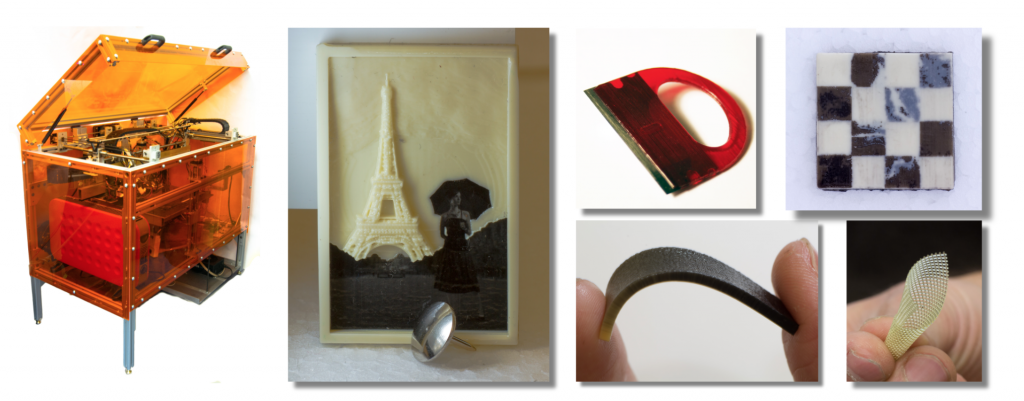A group of students and researchers originating from the MIT Computer Science and Artificial Intelligence Laboratory (CSAIL) has just built and presented a new approach to 3D printing that could enable low-cost, multi-material and multi-process digital fabrication through the implementation of 3D scanning based computer vision.
The project, dubbed Multi-Fab, allows, among other things, for self-calibration of printheads, 3D scanning, and a closed-feedback loop to enable print corrections, as well new applications such as 3D printing over auxiliary parts. Over time, this could lead to both affordable multi-material printing with as many as 10 to 15 different materials, as well as single-process fabrication of microlens arrays, fiber optic bundles, printed textures, complex meta-materials, fabrics, multi-color objects, LED lenses and more.
The way the machine works is reminiscent of other fascinating projects we have seen recently, and that we have described as the most likely evolution of 3D printing. These include Maker projects such as the IR3 assembly bot and the 5axismaker, as well as the concept of Shaped Deposition Manufacturing introduced by Stanford. Of course, these projects are very different and present very different perspectives; however, they all share the idea of creating complex objects through multiple manufacturing methods working together, in other words.
The MIT CSAIN project differs in that it makes intensive use of 3D scanning and machine vision. This hardware-software application performs four main functions: a geometric calibration of the printheads with respect to the build platform and the positioning system, 3D scanning of printed objects, 3D scanning of auxiliary objects, and an alignment of auxiliary parts with a model to be printed.
This gives the Multi-Fab the ability to 3D print on pre-existing objects and integrate other objects into the 3D prints as they happen. The 3D printing process itself can use up to 10 different materials that interact optically and mechanically. These currently include a rigid material (RIG), an elastic material (ELA), a high refractive index material (HR), a low refractive index material (LR), and a support material (SPT).
It can achieve a resolution of 40 microns by using standard 2D piezoelectric inkjet printheads adapted for 3D printing (which is similar to the way Stratasys’ PolyJet technology works, the current de-facto standard in multi-material 3D printing). In order to keep costs well below those of Stratasys’ high-end systems, the Multi-Fab team used a modular approach. This means that the machine is made up of several modules that can be expanded.
One is the 3D scanning module, which concludes a camera setup with a Michelson interferometer. It is used for system calibration, print inspection, and depth estimation. Another module, the Material Feeding Subsystem, feeds printing materials to the printheads and maintains adequate pressure and temperature. Other modules include the pritnhead, featuring 600 DPI resolution and nozzles that can eject droplets ranging from 6 pL to 26 pL in volume, and the UV Curing system, which includes ten high-efficiency 365 nm UV LEDs, an off-the-shelf LED driver, and a fan.
Javier Ramos, one of the study’s seven authors, points out that the ability to fully exploit the machines capability will depend on a radically new approach to 3D design, one that takes into consideration different materials, and thus a whole new generation of 3D modeling software. This will take time, but more and more projects indicate that it is the way to go.





